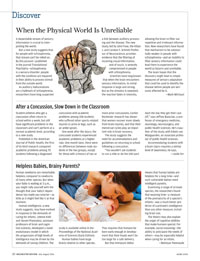In Review
 (Photo: Adobe Stock)
(Photo: Adobe Stock)A dependable stream of sensory information is crucial to interpreting the world.
But a new study suggests that for people with schizophrenia, that stream can’t be relied on. By this account—published in the journal Translational Psychiatry—schizophrenia is a sensory disorder: people with the condition are impaired in their ability to process stimuli from the outside world.
As auditory hallucinations are a hallmark of schizophrenia, researchers have long suspected a link between auditory processing and the disease. The new study, led by John Foxe, the Kilian J. and Carolyn F. Schmitt Professor of Neuroscience, provides evidence that the filtering of incoming visual information, and of touch, is severely compromised in people with schizophrenia.
Scientists have long known that when the brain encounters sensory information, its initial response is large and strong. But as the stimulus is repeated, the reaction fades in intensity, allowing the brain to filter out repetitive and irrelevant information. Now researchers have found that mechanism to be substantially weaker in people with schizophrenia—and an inability to filter sensory information could lead them to experience the world as bizarre and unreliable.
The team hopes that the discovery might lead to simple measures of sensory adaptation that could be used to identify the disease before people are seriously affected by it.
—Mark Michaud
After a Concussion, Slow Down in the Classroom
Student-athletes who get a concussion often return to school within a week, but still have significant problems in the classroom and can’t perform at a normal academic level, according to a new study.
Published in the American Journal of Public Health, the first-of-its-kind research compared academic problems among 70 students following a diagnosed concussion with academic problems among 108 students who suffered other sports-related injuries to arms or legs, such as an ankle sprain.
One week after the injury, the concussed students experienced academic problems at a higher rate. One month later, there were no differences between male students in the two groups, except for those with a history of two or more prior concussions. Earlier Rochester research has shown that women recover more slowly from brain injuries, and that their menstrual cycles play an important role in brain recovery.
The study suggests the need for accommodations and guidelines on returning to school following a concussion.
“You wouldn’t ask students to run a mile or do the 100-yard dash the day they get their cast off,” says Jeffrey Bazarian, a professor of emergency medicine, neurology, neurosurgery, and public health sciences. He’s coauthor of the study, with Edwin van Wijngaarden, an associate professor of public health sciences.
Accommodating students with a brain injury requires a similar level of awareness, he says.
—Leslie Orr
 (Photo: Adobe Stock)
(Photo: Adobe Stock)Helpless Babies, Brainy Parents?
Human newborns are remarkably helpless compared to newborns of many other species. But when your baby is wailing at 3 a.m., you might rally yourself with the thought that your baby’s dependence has made you smarter—as little as it might feel like it at that moment.
Human intelligence, a new study suggests, may have evolved in response to the demands of caring for infants. Celeste Kidd and Steven Piantadosi, assistant professors of brain and cognitive sciences, developed a novel evolutionary model in which the progression of high levels of intelligence may be driven by the demands of raising children. The study is available online in the Proceedings of the National Academy of Sciences (Early Edition).
Human babies have large brains relative to other species. That requires that humans be born early enough in development that their heads won’t be too large for a safe delivery.
But that immature debut means that human babies are helpless for a long time—and such vulnerable babies need intelligent parents.
Examining a range of primate species, the researchers found that weaning time—a measure of the prematurity of a species’s infants—was a much better predictor of a primate’s intelligence than any other measure, including brain size.
The theory may also explain the origin of cognitive abilities that make humans special. For example, social reasoning—the ability to anticipate the needs of others—may be especially helpful when caring for an infant.
—Monique Patenaude
 ICY: Pluto’s largest moon, Charon, is cracked, and new research suggests an encounter with another body might be the cause. (Photo: NASA/JHUAPL/SwRI (Charon))
ICY: Pluto’s largest moon, Charon, is cracked, and new research suggests an encounter with another body might be the cause. (Photo: NASA/JHUAPL/SwRI (Charon))A Crack in the Moon
A new computer model could offer an explanation for how cracks on icy moons, such as Pluto’s Charon, formed.
Until now, it was thought that the cracks were the result of geodynamic processes, such as plate tectonics. But research by Alice Quillen, a professor of physics and astronomy, and her collaborators suggests that a close encounter with another body might be the cause.
Astronomers have long known that the craters visible on moons were caused by the impact of other bodies, billions of years ago. But for every crash and graze, there would have been many more close encounters. By devising and running a new computer model, Quillen has shown that the tidal pull exerted by another, similar object could be strong enough to crack the surface of icy moons.
Such moons exhibit what’s known as “brittle elastic behavior.” Quillen likens it to Silly Putty, which bounces when thrown but breaks apart when stretched hard and fast.
Quillen’s computer model constructed the moons’ interiors as if they were made up of many bodies connected by springs—a method inspired by computer-graphics code. “The inside of the moons is similar to how blood splatter is modeled in games, and the outer icy crust is similar to modeling clothes and how they move,” she says.
In the paper, to be published in the journal Icarus, Quillen explains that the key factor for cracking is the strain rate—the rate of pull from another body that would have caused the moons to deform at a rate that their top, icy layer couldn’t sustain, leading to cracks.
—Leonor Sierra
Can’t Resist Temptation? That May Not Be Bad
Classic 1970s “marshmallow tests” assessed impulse control in preschoolers, offering one marshmallow immediately, or two if the kids waited several minutes. Children who displayed an apparent lack of control by taking the single treat were deemed “maladapted.” Follow-up studies identified children raised in poverty as far less likely to postpone temptation than their richer counterparts.
But a new study published in the journal Psychological Science suggests that the “maladapted” label needs revision. What looks like selfishness may actually be beneficial behavior for a child raised in an environment with scant resources.
“Kids who are brought up in homes with limited resources have learned it’s advantageous to seize the moment,” says Melissa Sturge-Apple, an associate professor of psychology and a clinical researcher at the Mt. Hope Family Center.
Sturge-Apple measured the “vagal tone” of preschoolers before they took part in reward-based experiments. The vagus nerve streams information from the heart, lungs, stomach, and other organs to the brain. It’s associated with the moderation of moods, including fear and anxiety. High vagal tone is a physiological indicator of “grace under fire”—the ability to slow down heart rate, blood pressure, and respiration, which can allow for a thoughtful response.
Previous research had shown that for children in affluent households, high vagal tone predicts their ability to delay gratification: the higher their vagal tone, the longer they can wait.
But in the Rochester study, children from low-resource households with high vagal tone demonstrated the opposite behavior: the higher their vagal tone, the more quickly they opted for the single treat.
“When all is well and prosperous, kids who are highly attuned to what is going on around them can wait, but when things are scarce and unpredictable, then the question becomes ‘why wait?’ ” says Sturge-Apple.
—Monique Patenaude

